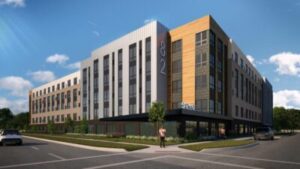|
|
By Ronald Calhoun
The city says there is a need for more population density. The Ward 7 community at a recent community meeting agreed to discuss concerns over Marous Development Group, which is building a 139-unit, five-story, market-rate apartment building on 82nd street in Hough. Throughout the room the consensus was not against development, but for the need for investment, engagement, and connection with the community by the city and the developers. The City of Cleveland has ignored residents in Little Italy, University Circle (Hessler Rd.), Hough (Famico’s.), and once again in Hough (82nd St. development ).
Most times when a project is presented to Cleveland City Planning, Commission member August Fluker asks the same question, “have you talked to the community?” If you review the YouTube videos of the Cleveland City Planning Commissioner’s meetings, it’s amazing how many times the question is not answered. It’s just not fair to any of the parties who are involved. It’s not fair to the developers, the Design and Review Committee, the City Planning Commissioners, and most importantly, the community.
Resident, LaJean Ray said, “We need to provide housing for our legacy homeowners and our seniors who are eventually going to downsize and can’t afford market-rate apartments.”
Rhonda Bowman-Raines, another resident, stated, “Essentially, my home will be surrounded by concrete. This is a complete change to the landscape of the neighborhood and the neighborhood appeal. This huge edifice will be sitting on the corner covering up homes that have been here for decades. This was not the trajectory anticipated for the Hough area. It was anticipated that this area would once again thrive as a well-defined neighborhood, with a diversity of individuals, and a diverse housing stock entertaining home ownership in the heart of the City. This monstrous apartment does not add to that. Homeownership that generally thrives in a neighborhood is lost on this type of edifice. It also does not lend itself to a diverse background of people living in the area since these apartments will go for market rate. I deliberately chose this area because it reflected a diverse background of people; not just those who can afford to live in market-rate apartments. I am not against development in the Hough area, but the development has to be done to MAINTAIN and INCREASE the neighborhood appeal, not OBLITERATE it.”
Several other residents expressed concern and were not hesitant to say they do not want this kind of development.
“I agree, the process for development in the city of Cleveland is broken,” said Council President Blaine Griffin.
The City of Cleveland wants more development to gain more population density. The community also wants development but on different terms, for example, development that is aesthetically comparable to the existing housing. Here in lies the clash.
Let’s take a look at the development landscape in the housing market in Cleveland and some solutions the city needs to consider.
Post-pandemic, the indicators show that the housing market is booming! Of the households in Cleveland, 55% are occupied by renters. This seems to indicate that the market is perfect for rental property investment. Rental property investment is usually based on single-family housing prices. When there is a surge in housing prices, generally there is a surge in availability in the rental market.

The reason Cleveland is so attractive is that homes are selling quickly, and the average price is affordable. The average price for a home in Cleveland is $115,000. The diversified economy also helps the surging housing market in Cleveland. If the price of single housing grows, this will make the rental market strong in Cleveland.
There are a couple of things to consider, however. Cleveland has seen its population shrink by over 6% between 2010 and 2020. Secondly, the city’s population is nearly 373,000 and the metropolitan population is more than 2 million, ranking Greater Cleveland as the 34th-largest metro area in the U.S. The population of Cleveland has decreased 2% year-over-year but the median household income grew by 1.8%. That is the result of a job market that has increased.
The most affordable neighborhoods in Cleveland for renters include North Broadway, Mount Pleasant, and South Collinwood, where rent averages less than $850 per month.
The most expensive areas to rent include Downtown Cleveland, Hough, and Tremont, where average rent ranges between $2,250 and $2,550 per month.
Cleveland has an affordability index of 1 out of 10, meaning the metro area is one of the more affordable places to own a home in the U.S.
What does all this mean? The housing market has to increase for the rental market to increase. In effect, that is not happening enough to justify the number of new apartments and other multi-unit developments between 55th Street and 105th Street on the Chester Avenue corridor where there are older homes and new custom homes.
There are many consequences to rental development without paying attention to the housing market. The following community considerations need to be addressed:
- Lack of new housing
- Lack of present owner Incentives
- Access for lower income households
- Reduced property values
- Long-term effects of tax abatement
- Lack of quality retail
- Education disparity
- Parking variance burden to adjacent houses
Ward 7 has a wide variety of family demographics which makes it very difficult to manage as a political leader. There are legacy homeowners who have never given up on the community. There are the new legacy owners who chose to build in Hough. Also, there are renters who would love to purchase a home in Ward 7. The community has come to realize that Ward 7 is becoming the best location in the “Best Location in the Nation.”
The guiding principle in selling or purchasing a home is Location! Location! Location! That includes good schools, easy access to transportation, and good shopping.
Once the City of Cleveland starts to:
- enforce housing, retail, and commercial laws,
- limit tax abatements to potential homeowners,
- focus on incentives to grow businesses and retail, and
- continue to evolve the public schools to attract diversity, the density will follow.
Once Cuyahoga County
- stops dragging its feet on foreclosures,
- ends the favoritism of Community Development Companies (CDC) getting access to land before the public,
and the State of Ohio
- stops giving out vouchers that kill the public school system;
everyone will want to live in Hough, Fairfax, Central, Glenville, and Buckeye.
The immediate solution?
- Legislation is needed to hold community meetings before the developers submit a proposal. The present process is not fair to the developer or the community.
- There should be 50% representation from the community on the City of Cleveland’s neighborhood design and review committees.
Residents should not fear expressing what they want from leadership. The question is, will the city respond to what the residents want?





